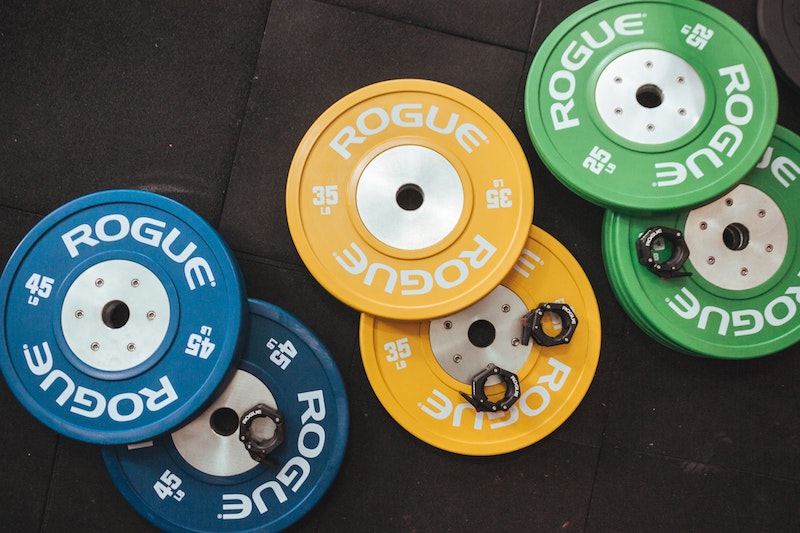
When you want greater freedom with your workouts, free weights are an excellent choice.
With machines, you’re limited in your range of motion — which can sometimes be unnatural and less than ideal for your body.
Getting stronger is just one of the many benefits that come with working out with free weights. They also help improve your balance, boost your athleticism, and limit your risk of injury compared with weight machines.
But free weights aren’t all the same. In fact, there are six main varieties you typically find at the gym.
The main types of free weights are:
- Dumbbells
- Barbells
- Standard & Olympic weight plates
- Medicine balls
- Sandbells
- Kettlebells
Each one comes with its own unique advantages, and depending on what your goals are, you may want to use some but not others — or a combination of all of them.
Here are various free weight options available to you. Choose wisely so you perform at your very best.
Dumbbells
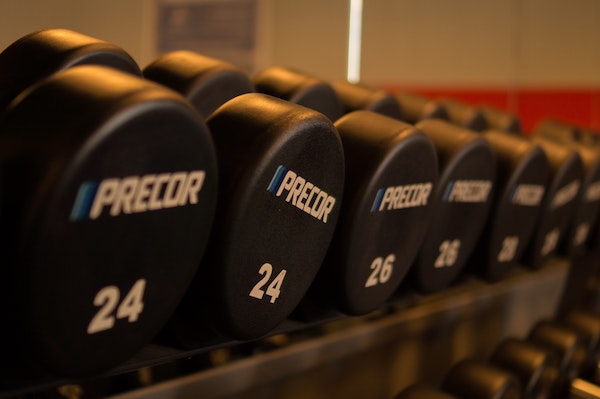
When it comes to strength training, dumbbells should be integral components of your workouts.
You can use them individually or in pairs. Some are adjustable in terms of weight while others come fixed.
Dumbbells are highly recommended for joint-isolation exercises, including shoulder raises, chest flyers, and bicep curls.
However, you can also use dumbbells to perform compound movements like squats, shoulder press, bench press — pretty much anything you could do with a barbell, and more.
There are two primary ways in which dumbbells offer muscle growth through overload: metabolic and mechanic.
Metabolic overload happens when muscles are worked to the point of fatigue. This forces muscle cells to store greater quantities of glycogen, which results in the muscles increasing in size.
Mechanic overload occurs from damage from muscle contractors. This then stimulates the repair process, resulting in an increase in muscle size.
Generally, moderate-weight dumbbells lead to metabolic overload while heavy dumbbells mostly lead to mechanical overload.
Whatever training style you choose, dumbbells are an extraordinarily versatile tool. Use them for:
- Goblet squats
- Bench press
- Shoulder press
- Romanian deadlifts
- Chest flys
- Lateral raises
- Rear delt flys
- And so much more
If you can afford just one piece of equipment for strength training at home, it should be a set of dumbbells.
And for strength training and gaining muscle at the gym, don’t skip the dumbbell section!
Barbells
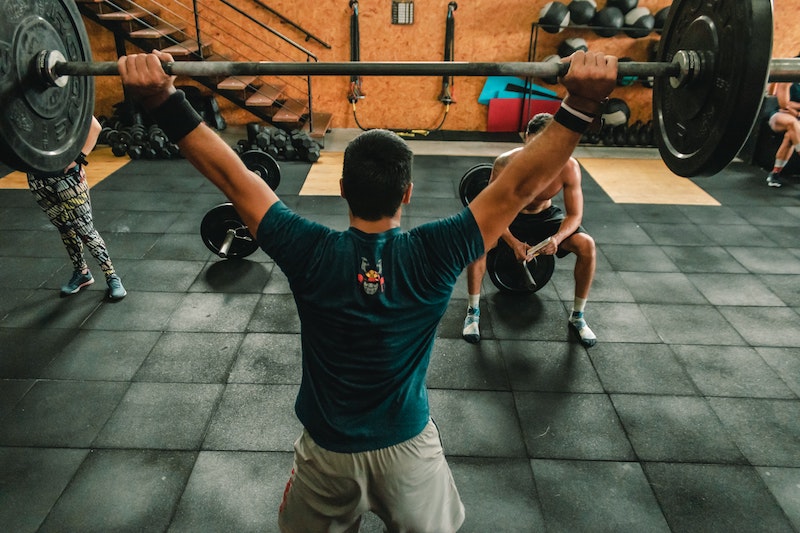
Dumbbells are great for building stability, getting deep range of motion, and isolating muscles.
But for raw strength, you’ll want to incorporate barbell training into your routine.
Barbells consist of long bars with weights on both ends. Some are simple straight bars, others have special shapes and grips including the EZ bar, trap bar, hex bar, and more.
They’re generally used for bodybuilding, powerlifting, and weightlifting movements.
However, you don’t have to train for the Olympics to gain the advantages of working out with these free weights.
Some of the exercises you can look into with barbells include:
- Lunge
- Overhead press
- Bent-over row
- Bench press
- Back squat
- Deadlift
- Power clean
Barbells are highly recommended for athletes or anyone training for maximum strength.
The reason is that working out with a barbell teaches you how to use all of your muscles in tandem to complete a singular goal: move a heavy object.
By lifting barbells, you innately improve your ability to rotate your core, run faster, swing, punch, and kick.
It’s common to load up a barbell with weight plates (which we’ll get to), but you can also get in a great workout just using the bar.
A standard Olympic barbell weighs 45 pounds, after all, with smaller or specialty barbells weighing anywhere from 10 to 25 pounds.
Standard & Olympic weight plates
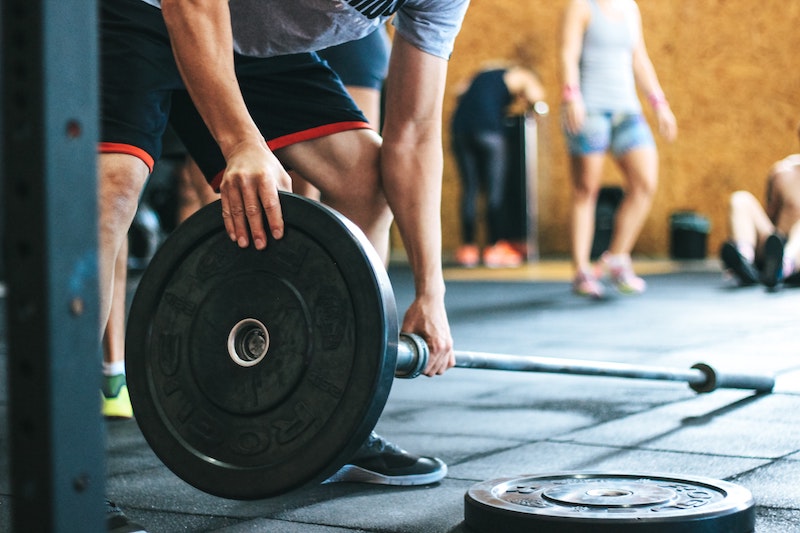
At some point, you’ll need to add some weight to that barbell to continue seeing strength gains.
Enter: Weight plates, another type of free weight you’ll see at the gym.
There are two types of weight plates: Standard and Olympic, with Olympic being far more common and versatile.
The difference here is that standard plates have a 1″ diameter hole in the middle in order to fit a smaller, standard barbell.
Olympic plates have a 2″ diameter hole and fit your regulation Olympic barbell, which weighs 45 pounds.
(This is what you’ll most commonly find at the gym.)
In addition to loading the plates onto a barbell for big, compound lifts (like bench press and deadlift), you can use these free weights individually for certain exercises like:
- Lateral raise
- Front shoulder raise
- Plate push-up
- Overhead press
- Side bend
- Squat reach
Some Olympic weights have a layer of rubber surrounding the core, making them ideal for deadlifting or explosive weightlifting movements. Others have grips around the edges of the plate for safer loading and unloading, or to help you use the plate on its own without a barbell.
If you want to lift heavy and build awesome strength, you’ll need to get familiar with the rack of Olympic plates at the gym.
Medicine balls
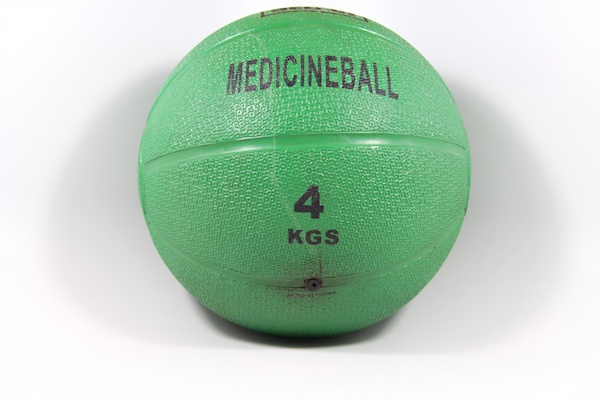
Medicine balls are basically weighted balls with a diameter of about 13.7 inches.
They’re most often used for strength training as well as rehabilitation.
They’re primarily used in sports medicine to help with neuromuscular coordination and strength improvement.
Most of the time, they weigh between two and 25 pounds, and there is a sharp distinction between medicine balls and exercise balls, which are usually larger.
However, even if you aren’t recovering from an injury, you can still find medicine balls at many gyms. Some exercises that are great to utilize include:
- Side to side slams
- Ball twists
- Ball slams
- Squat throws
- Wall ball
You can even get more out of your medicine ball workout by having someone assist you.
For example, you can have someone gently toss you the ball. Once you catch it, you touch the floor with it on both your left and right sides. After that, you toss it back to the person.
You can do this with a friend or find someone at the gym to help you out.
This makes medicine balls one of the best pieces of equipment to help with socialization and making friends.
They’re also fun to use and, surprisingly, can give you an awesome full body workout.
You probably wouldn’t want to do 100% of your strength training with a medicine ball, but for rehab and specialty athletic work there’s nothing better.
Sandbells

The sandbell takes the best features of other free weights and combines them into one useful tool.
It’s essentially a bag filled with a specially-formulated sand to give it weight— a compact, easily grab-able sandbag.
Since sand constantly moves inside it, you always need to adjust to balance yourself out. That’s great for building your stabilizer muscles and overall balance.
Part of an effective weight workout consists of constantly surprising your muscles and giving them something different to react to.
For instance, you can incorporate a sandbell into a lunge rotation. This is when you hold the sandbell near your torso with bent elbows.
Step forward with a lunging motion and twist to one side. From there, you push off of your front foot to get back to your starting position. Repeat with the other side, and that’s one rep.
Other exercises you can do with sandbells include:
- Woodchop
- Bent-over row
- Rainbow slam
- Skater
- Russian twist
- Hip swing
Sandbells are great for people who want something a little safer.
With barbells and dumbbells, there’s always a small risk one will fall and land on your foot.
Since these free weights are filled with sand, they tend to be lighter or at least more pliable. Sand also feels a lot better than steel when it comes crashing down on your toes!
Kettlebells
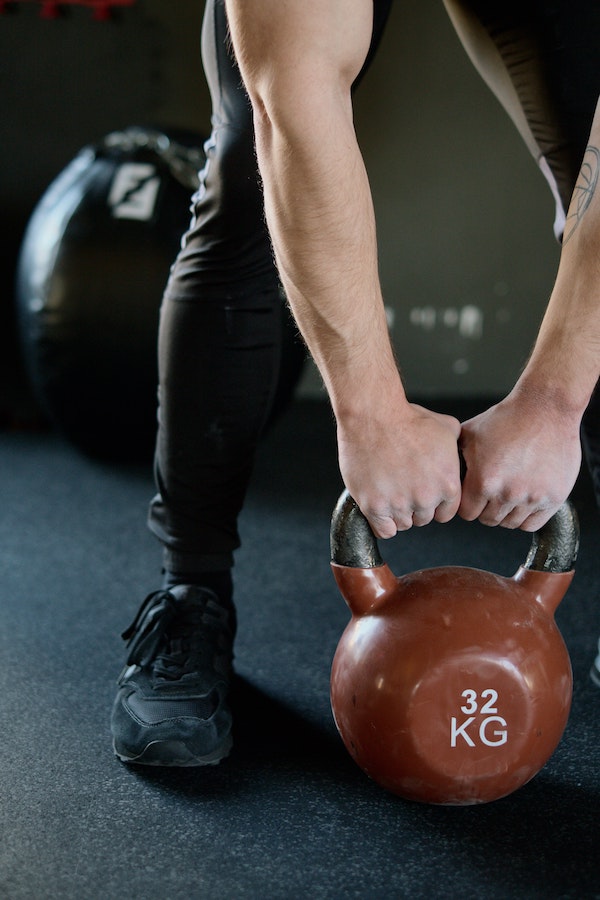
Kettlebells are cast iron weights that weigh anywhere between five and over 100 pounds.
They come with a handle on top that makes for easier gripping.
With the myriad of workouts you can do with a kettlebell, you can receive a killer full body workout.
You don’t need anything else to supplement it. All you need is your hands and the willpower to keep going.
Kettlebells are excellent for explosive, athletic movements. Because of the shape of the weight and the handle, you can do lots of unique, dynamic lifts with kettlebells that would be impossible with other kinds of weight.
Some great exercises to get started include:
- Goblet squat
- One-arm row
- One-arm press
- Shoulder halo
- Around the leg pass
- Chest-loaded swing
When you want to work out your shoulders, legs, and lower back, reach for the kettlebell.
Not only will you build muscle, but you’ll also greatly improve your grip strength by working with the specialized handle on a kettlebell.
(Grab some kettlebells for home with my guide to the best kettlebells for beginners or read more about the pros and cons of kettlebell workouts.)
What’s not considered a free weight
All of these free weights come with their advantages and best practices.
But they’re not the only types of weights or resistance training around.
Some of these other types of weights that would NOT be considered free weights include:
- Resistance machines
- Bands
- Leg presses
- Smith machines
That’s not to say resistance machines shouldn’t have a place in your workout regimen.
But it all comes down to what you hope to attain.
Free weights are better for building muscle more quickly and working in an athletic, natural range of motion.
However, resistance machines are easier to use and may be more recommended for beginners.
Wrapping up
Free weights are the best way to build strength and muscle in the gym (or at home!).
Machines and resistance bands have their place, but they won’t give you nearly the same athletic, powerful foundation.
Beginners would do best to start with basic dumbbell exercises and begin to incorporate barbell work or specialized weights like kettlebells when they’re ready.
Here are some guides that can help you learn a little bit more about free weights:
- How much do dumbbell bars weigh?
- How much is a plate?
- How much do dumbbells cost?
- How much do Olympic weights cost?
Hope this helps!